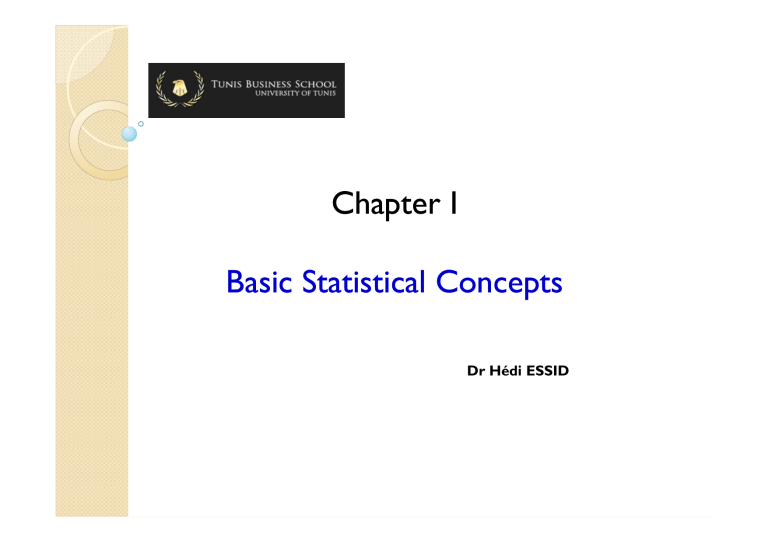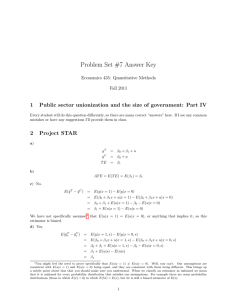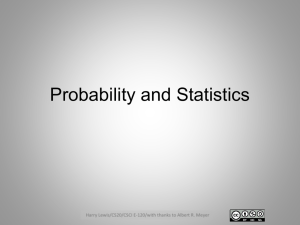
Chapter I Basic Statistical Concepts Dr Hédi ESSID Discrete and Continuous Random Variables A random variable is any variable whose value cannot be predicted exactly. A discrete random variable is one that has a specific set of possible values. An example is the total score when two dice are thrown. An example of a random variable that is not discrete is the temperature in a room. It can take any one of a continuing range of values and is an example of a continuous random variable. 2 Expected Value of Random Variable The expected value of a random variable is the weighted average of all its possible values, taking the probability of each outcome as its weight. In mathematical terms, if the random variable is denoted X, its expected value is denoted E(X). 3 Expected Values of Functions of Random Variables Let g(X) be any function of X. Then E[g(X)], the expected value of g(X), is given by i =n E [g ( X )] = ∑ g ( xi )pi if X is Discrete i =1 E [ g ( X )] = ∫ g ( X )f ( X )dx if X is Continous 4 Independence of Random Variables Two random variables X and Y are said to be independent if , E[g(X)h(Y)] = E[g(X)].E[h(Y)] for any functions g(X) and h(Y). Independence implies, as an important special case, that E(XY) = E(X).E(Y) 5 Expected Value Rules Rule 1 The expected value of the sum of several variables is equal to the sum of their expected values. For example, if you have three random variables X, Y, and Z, E(X + Y + Z) = E(X) + E(Y) + E(Z) Rule 2 If you multiply a random variable by a constant, you multiply its expected value by the same constant. If X is a random variable and b is a constant, E(bX) = bE(X) Rule 3 The expected value of a constant is that constant. For example, if b is a constant, E(b) = b 6 Population Variance of Random Variable The population variance, is defined as the expected value of the square of the difference between X and its mean, that is, of (X – µ)2, where µ is the population mean. It is usually denoted σ X2 σ = E ( X − µ ) = ∑( x i −µ ) pi if X is Discrete 2 X 2 2 2 = ∫ ( x − µ ) f ( x)dx if X is Continuous 7 Variance Rules Rule 1 If Y = V + W, Var(Y) = Var(V) + Var(W) + 2Cov(V, W). Rule 2 If Y = bZ, where b is a constant, Var(Y) = b2Var(Z). Rule 3 If Y = b, where b is a constant, Var(Y) = 0. Rule 4 If Y = V + b, where b is a constant, Var(Y) = Var(V). 8 Covariance and Correlation Population Covariance If X and Y are random variables, the expected value of the product of their deviations from their means is defined to be the population covariance, σXY: σXY = E[(X – µX)(Y – µY)] where µX and µY are the population means of X and Y, respectively. 9 Covariance and Correlation Sample Covariance Sample Covariance is a measure of association between two variables. The sample covariance, Cov(X, Y), is a statistic that enables you to summarize this association with a single number. In general, given n observations on two variables X and Y, the sample covariance between X and Y is given by 1 Cov( X,Y ) = ∑( x i −x )( yi − y ) n 10 Covariance and Correlation Some Basic Covariance Rules Rule 1 If Y = V + W, Cov(X, Y) = Cov(X, V) + Cov(X, W) Rule 2 If Y = bZ, where b is a constant and Z is a variable, Cov(X, Y) = bCov(X, Z) Rule 3 If Y = b, where b is a constant, Cov(X, Y) = 0 11 Covariance and Correlation Sample Variance For a sample of n observations, X1, ..., Xn, the sample variance will be defined as the average squared deviation in the sample: 1 Var ( X ) = ∑ X i − X n ( ) 2 12 Covariance and Correlation Sample Variance The sample variance, thus defined, is a biased estimator of the population variance. We can demonstrate that s2 is an unbiased estimator of σ2. 1 s = Xi − X ∑ n −1 2 ( ) 2 13 Covariance and Correlation The Correlation Coefficient Like variance and covariance, the correlation coefficient comes in two forms, population and sample. The population correlation coefficient is traditionally denoted ρ, the Greek letter that is the equivalent of “r”, and pronounced “row”, as in row a boat. For variables X and Y it is defined by ρ XY = σ XY σ X2 σ Y2 14 Covariance and Correlation The Correlation Coefficient If X and Y are independent, ρXY will be equal to 0 because the population covariance will be 0. If there is a positive association between them, σXY, and hence ρXY, will be positive. If there is an exact positive linear relationship, ρXY will assume its maximum value of 1. Similarly, if there is a negative relationship, ρXY will be negative, with minimum value of –1. 15 Covariance and Correlation The Correlation Coefficient The sample correlation coefficient, rXY, is defined by replacing the population covariance and variances by their unbiased estimators: r XY = Cov ( X ,Y ) Var ( X )Var (Y ) 16 Estimators So far we have assumed that we have exact information about the random variable under discussion, in particular that we know the probability distribution, in the case of a discrete random variable, or the probability density function, in the case of a continuous variable. In practice, except for artificially simple random variables, you do not know the exact probability distribution or density function. It follows that you do not know the population mean or variance. However, you would like to obtain an estimate of them or some other population characteristic. 17 Estimators The procedure is always the same: You take a sample of n observations and derive an estimate of the population characteristic using some appropriate formula. You should be careful to make the important distinction that the formula is technically known as an estimator; the number that is calculated from the sample using it is known as the estimate. The estimator is a general rule or formula, whereas the estimate is a specific number that will vary from sample to sample. 18 Estimators The usual estimators for the two most important population characteristics : 19 Estimators Are Random Variables An estimator is a special case of a random variable. This is because it is a combination of the values of X in a sample, and, since X is a random variable, a combination of a set of its values must also be a random variable. For instance, take X , the estimator of the mean: X= 1 Xi ∑ n 20 Unbiasedness Since estimators are random variables, it follows that only by coincidence will an estimate be exactly equal to the population characteristic. We should like the expected value of the estimator to be equal to the population characteristic. If this is true, the estimator is said to be unbiased. If it is not, the estimator is said to be biased, and the difference between its expected value and the population characteristic is described as the bias. 21 Efficiency Unbiasedness is one desirable feature of an estimator, but it is not the only one. Another important consideration is its reliability. It is all very well for an estimator to be accurate on average in the long run, but, as Keynes once said, in the long run we are all dead. We want the estimator to have as high a probability as possible of giving a close estimate of the population characteristic, which means that we want its probability density function to be as concentrated as possible around the true value. One way of summarizing this is to say that we want its population variance to be as small as possible. 22 Efficiency Suppose that we have two estimators of the population mean, that they are calculated using the same information, that they are both unbiased, and that their probability density functions are as shown in Figure R.8. Since the probability density function for estimator B is more highly concentrated than that for estimator A, it is more likely to give an accurate estimate. It is therefore said to be more efficient, to use the technical term. 23 Efficiency 24 Conflicts between Unbiasedness and Minimum Variance 25 Consistency In general, if the plim of an estimator is equal to the true value of the population characteristic, it is said to be consistent. To put it another way, a consistent estimator is one that is bound to give an accurate estimate of the population characteristic if the sample is large enough, regardless of the actual observations in the sample. In most of the contexts considered in this text, an unbiased estimator will also be a consistent one. 26 Consistency It sometimes happens that an estimator that is biased for small samples may be consistent (it is even possible for an estimator that does not have a finite expected value for small samples to be consistent). The distribution is said to be asymptotically (meaning, in large samples) unbiased because it becomes centered on the true value as the sample size becomes large. It is said to be consistent because it finally collapses to a single point, the true value. An estimator is described as inconsistent either if its distribution fails to collapse as the sample size becomes large or if the distribution collapses at a point other than the true value. 27 Consistency Figure R.12 illustrates how the probability distribution might look for different sample sizes. 28 Methods of Estimation Consider a Normal distribution with unknown parameters mean µ and variance σ2. The estimator of µ could have been obtained by either of the following methods : Method of Moments Maximum Likelihood Estimation (MLE) Confidence of Intervals 29 Methods of Estimation 1. Method of Moments Simply stated, this method of estimation uses the following rule: Keep equating population moments to their sample counterpart until you have estimated all the population parameters. 30 Methods of Estimation 2. Maximum Likelihood Estimation (MLE) 31 3. Confidence of Intervals Estimation methods considered in the last paragraph give us a point estimate of a parameter, say µ, and that is the best bet, given the data and the estimation method, of what µ might be. But it is always good policy to give the client an interval, rather than a point estimate, where with some degree of confidence, usually 95% confidence, we expect µ to lie. We have seen in Figure 2.5 that for a N(0, 1) random variable z, we have Pr[−zα/2 ≤ z ≤ zα/2] = 1 − α and for α = 5%, this probability is 0.95, giving the required 95% confidence. In fact, zα/2 = 1.96 and Pr[−1.96 ≤ z ≤ 1.96] = 0.95 32 3. Confidence of Intervals This says that if we draw 100 random numbers from a N(0,1) density, (using a normal random number generator) we expect 95 out of these 100 numbers to lie in the [−1.96, 1.96] interval. Now, let us get back to the problem of estimating µ from a random sample x1, . . . ,xn drawn from a N(µ,σ2) distribution. We found out that µˆ = X and X ∼ N ( µ,σ 2 / n ) Hence, z = ( X − µ ) /(σ / n ) ∼ N ( 0,1) 33 3. Confidence of Intervals The point estimate for µ is X observed from the sample, and the 95% confidence interval for µ is obtained by replacing z by its value in the above probability statement: P ( − zα / 2 ≤ ( X − µ ) /(σ / n ) ≤ zα / 2 ) = 1 − α Assuming σ is known, one can rewrite this probability statement after some simple algebraic manipulations as P ( X − zα / 2 (σ / n ) ≤ µ ≤ X + zα / 2 (σ / n )) = 1 − α With the same confidence of drawing 100 random N(0,1) numbers and finding 95 of them falling in the (−1.96, 1.96) range we are confident that if we drew a 100 samples and computed a 100 X ’s, and a 100 intervals ( X ± 1.96σ / n ), µ will lie in these intervals in 95 out of 100 times. 34 3. Confidence of Intervals If σ is not known, and is replaced by s, leading to a t-distribution with (n−1) degrees of freedom. Hence, using the t-tables for (n − 1) degrees of freedom Pr[−tα/2;n−1 ≤ tn−1 ≤ tα/2;n−1] = 1 − α and replacing tn−1 by ( X − µ ) /(s / n ) one gets P ( X − tα / 2;n −1(s / n ) ≤ µ ≤ X + tα / 2;n −1(s / n )) = 1 − α 35 Hypothesis Testing The hypothesis testing problem (for the mean): make a provisional decision, based on the evidence at hand, whether a null hypothesis is true, or instead that some alternative hypothesis is true. That is, test H0: µ = µ0 vs. H1: µ > µ0 (1-sided, >) H0: µ = µ0 vs. H1: µ < µ0 (1-sided, <) H0: µ = µ0 vs. H1: µ ≠µ0 (2-sided) 36 Hypothesis Testing Example (2-sided ): H0 : µ=µ0 null hypothesis H1: µ≠µ0 alternative hypothesis (Indicated by economic theory) Under H0 µˆ − µ0 ∼ ST (n − 1) s( µˆ ) 37 Hypothesis Testing So we have t cal µˆ − µ0 = s( µˆ ) Decision rule (assuming significance level α ) If tcal > t n−1;α /2 then we can reject H0 µ is significantly different from µ0 If tcal and < t n−1;α /2 then we cannot reject H0 ( i.e we must accept H0 cannot accet H1) µ is not significantly different from µ0 38 Statistical tables 39 Statistical tables 40





